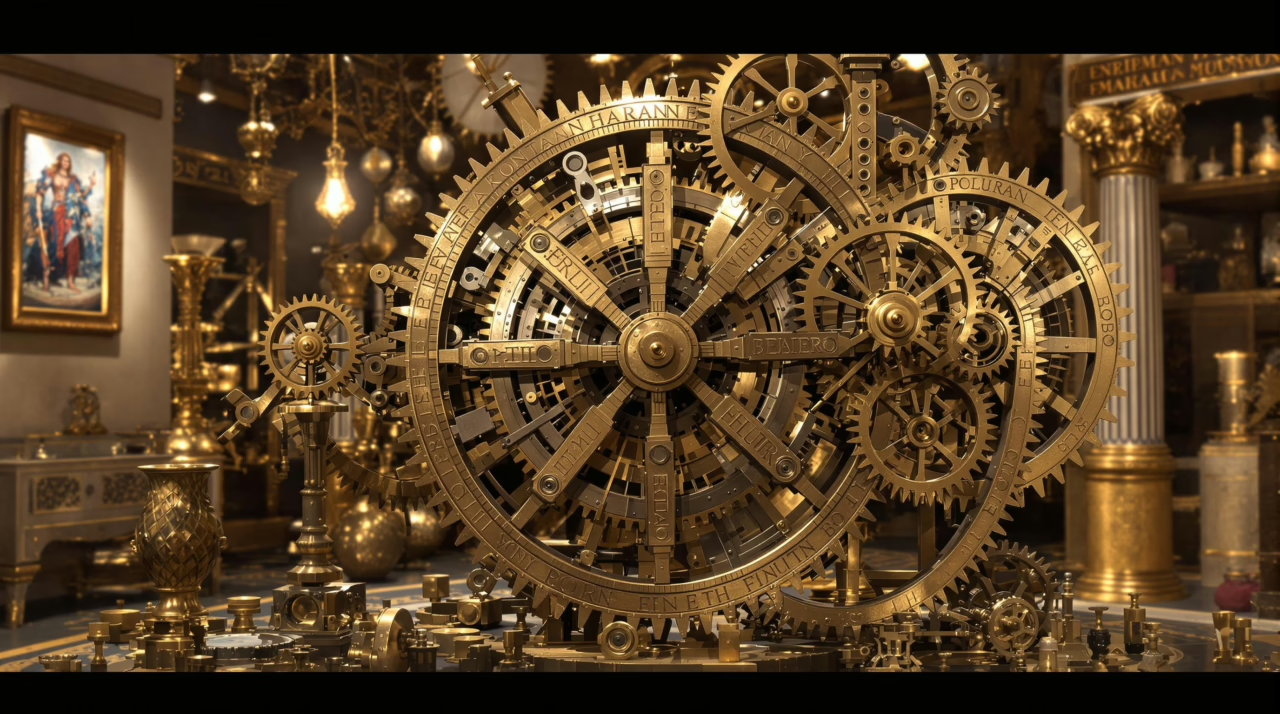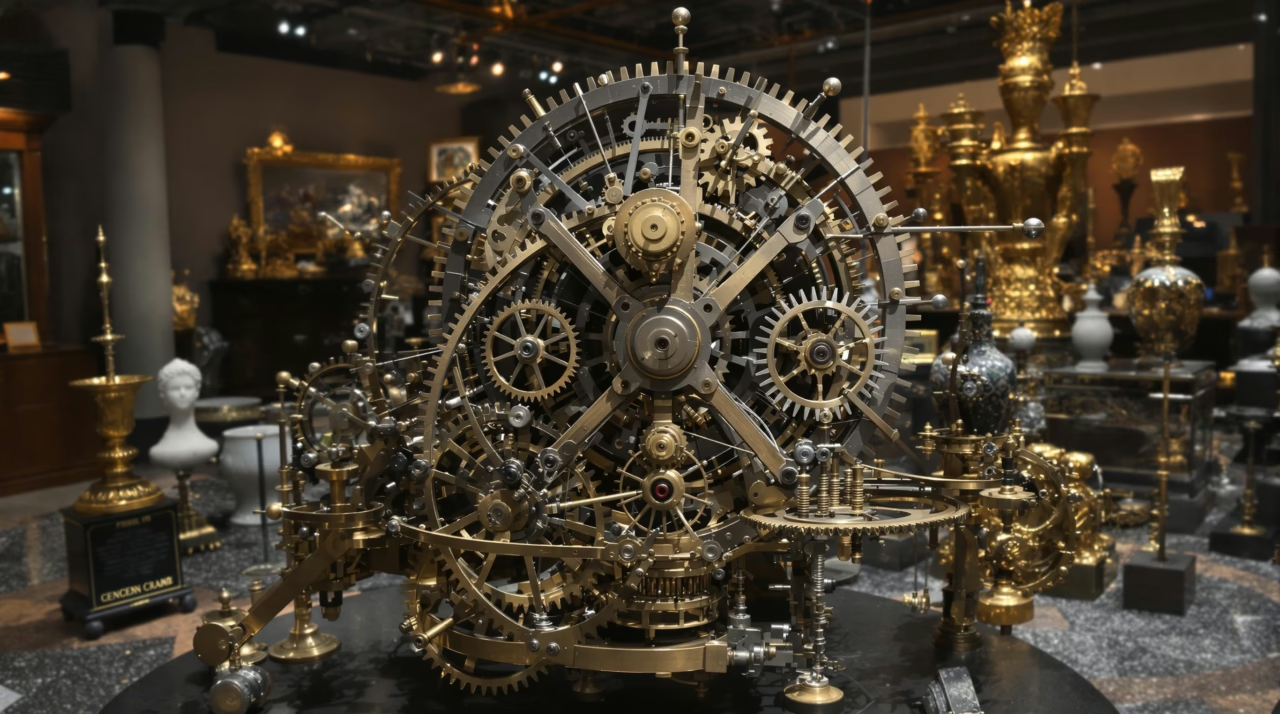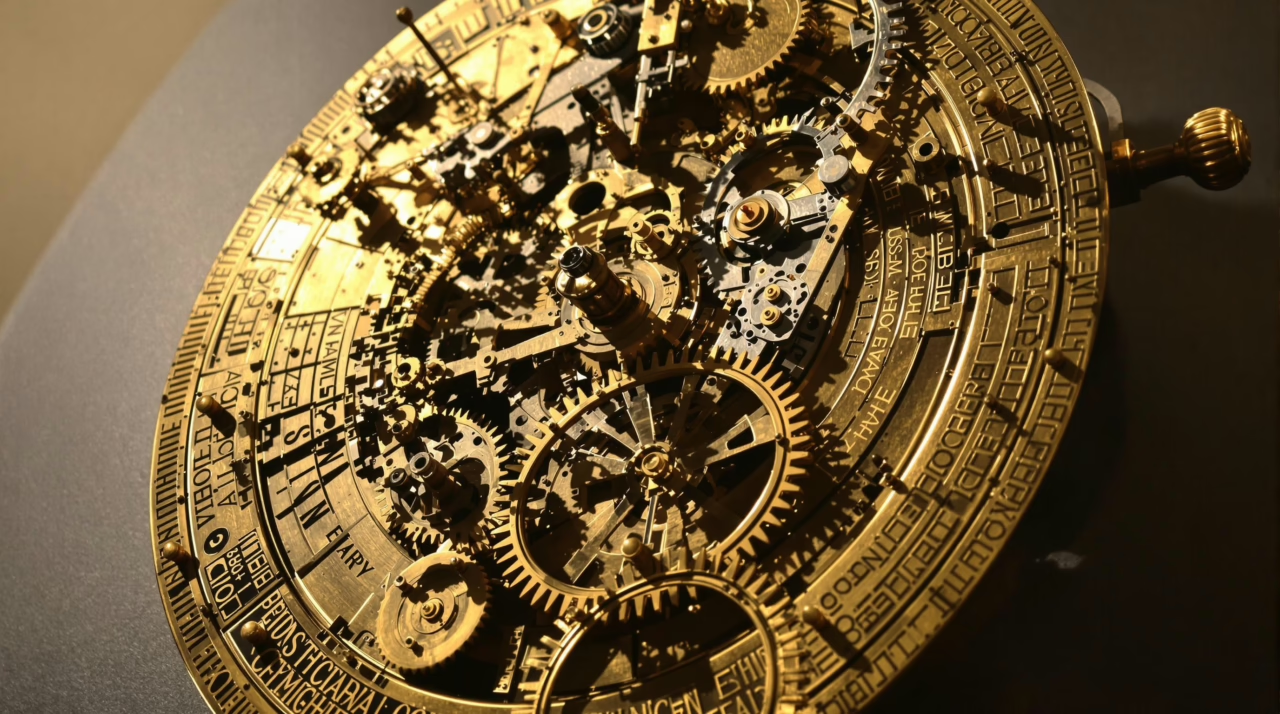Antikythera Mechanism: Ancient Computer

The Antikythera Mechanism stands as a demonstration of ancient engineering prowess.
Unearthed from a shipwreck, this complex device reveals sophisticated gear systems that predict celestial phenomena.
Its purpose extends beyond mere navigation, hinting at a deeper connection between humanity and the cosmos.
Scholars remain divided on its implications, sparking curiosity about its creators.
What secrets might this ancient computer still hold, and how does it influence our understanding of technology today?
Key Takeaways
Hide- The Antikythera Mechanism, dating back to 150-100 BCE, is considered the world's first analog computer.
- It features at least 30 interlocking bronze gears, showcasing advanced engineering and precision.
- The device predicts astronomical events, including eclipses and lunar phases, demonstrating sophisticated mathematical understanding.
- It was used for navigation, agricultural planning, and education in astronomy during ancient times.
- Ongoing research continues to reveal its complexity, inspiring modern scientific inquiry and technological advancements.
Discovery of Antikythera Mechanism Among Sunken Treasures

In 1901, a routine salvage operation off the coast of Antikythera uncovered a trove of artifacts from a long-lost shipwreck.
Yet it was the discovery of a peculiar device that would capture the imagination of scholars and historians alike.
This ancient mechanism, intricately constructed and shrouded in mystery, hinted at advanced astronomical knowledge far ahead of its time.
The implications of its existence challenge contemporary understandings of technology in the ancient world, prompting deeper inquiries into the civilization that created it.
The 1901 Shipwreck Unveiling
In 1901, the discovery of the Antikythera Mechanism amid a trove of bronze fragments sparked intense curiosity among archaeologists and historians alike.
Initial analyses of these remnants hinted at a sophisticated device, challenging preconceived notions of ancient technological capabilities.
This unexpected find not only illuminated the depths of maritime history but also posed profound questions about the knowledge and ingenuity of the ancient world.
The Intriguing Bronze Fragments
Unearthed from the depths of the Aegean Sea, the bronze fragments of the Antikythera Mechanism represent a remarkable intersection of technology and history, enchanting scholars and enthusiasts alike.
These intricate pieces, adorned with cryptic inscriptions and gears, evoke questions about ancient knowledge and its potential applications. They challenge contemporary understanding of technological evolution, urging a reevaluation of humanity’s historical ingenuity and its enduring legacy.
Identifying the Device in Early Analysis
The discovery of the Antikythera Mechanism among the sunken treasures of a 1901 shipwreck marked a pivotal moment in the understanding of ancient technological sophistication.
Initial analyses revealed intricate gears and inscriptions, prompting scholars to reconsider the extent of Hellenistic engineering.
This complex device, once dismissed as mere curiosity, now stands as a testament to human ingenuity, challenging modern perceptions of technological evolution.
Anatomy of an Ingenious Device: Ancient Computer

The Antikythera Mechanism stands as a testament to ancient ingenuity, showcasing a complex array of remarkable gears meticulously crafted for astronomical calculations.
Each cog and wheel reveals a level of precision that invites questions about the technological capabilities of its creators.
This intricate device not only highlights the sophistication of ancient engineering but also challenges modern perceptions of historical advancements in science.
Remarkable Gears and Precision Craftsmanship
The Antikythera Mechanism stands as a demonstration of the extraordinary capabilities of ancient engineers, showcasing an intricate network of interlocking gears that challenges modern perceptions of their technological prowess.
Each component, meticulously crafted from bronze, reveals a sophistication in design and function that surpasses the expected skills and materials of its time.
This remarkable device prompts a reevaluation of what was thought possible in the domain of ancient craftsmanship and mechanical innovation.
Interlocking Mechanisms Beyond Expected Skills
Although often overshadowed by its historical significance, the Antikythera Mechanism’s intricate design reveals a remarkable interplay of gears that challenges modern understanding of ancient engineering skills.
This ingenious device showcases:
- The complexity of interlocking gears.
- The precision required for astronomical calculations.
- The foresight in designing a mechanical model of celestial movements.
Such elements evoke admiration for the ingenuity of ancient minds.
Materials and Methods of Ancient Engineers
Ancient engineers demonstrated remarkable ingenuity in their choice of materials and methods, particularly evident in the construction of the Antikythera Mechanism.
Crafted from bronze, with intricately designed gears, this device showcased precision and foresight. The meticulous assembly of components reflects not only technical skill but also a deep understanding of celestial mechanics, revealing a profound desire for knowledge and exploration of the cosmos.
Purpose and Function: Tracking Celestial Events
The Antikythera Mechanism serves as a remarkable demonstration of ancient ingenuity, particularly in its ability to predict astronomical cycles with astonishing accuracy.
Its intricate design not only facilitated the tracking of celestial events but also played an essential role in navigation, guiding seafarers across the unpredictable seas of antiquity.
This device raises compelling questions about the intersection of technology, astronomy, and the cultural significance of celestial phenomena in ancient societies.
Predicting Astronomical Cycles
The Antikythera Mechanism stands as a demonstration of ancient ingenuity, meticulously crafted to predict celestial phenomena such as eclipses and lunar phases.
Its design not only reflects an advanced understanding of planetary movements but also aligns seamlessly with the mathematical principles of Greek scholarship.
This convergence of astronomy and mathematics reveals a profound desire to comprehend and anticipate the rhythms of the cosmos, prompting questions about the cultural and scientific implications of such knowledge.
Eclipses, Lunar Phases, and Planetary Movement
Celestial mechanics, a field that intertwines astronomy and mathematics, finds a remarkable embodiment in the Antikythera Mechanism, an ancient Greek device engineered to track eclipses, lunar phases, and planetary movements.
This intricate apparatus served to:
- Predict solar and lunar eclipses
- Monitor the synodic month
- Calculate the timing of celestial events
Such functionality reveals the profound understanding of the cosmos possessed by its creators.
Alignment with Greek Mathematical Knowledge
Remarkably, the Antikythera Mechanism not only exemplifies ancient engineering but also reflects the advanced mathematical concepts of its time.
Its intricate gears and ratios embody Greek understanding of cycles and harmonics, enabling precise predictions of celestial events.
This alignment with mathematical knowledge underscores humanity’s enduring quest for freedom through understanding, revealing how ancient civilizations sought to master the cosmos and their place within it.
Significance in Ancient Navigation
The Antikythera Mechanism served as an advanced tool for mapping celestial events, playing a pivotal role in ancient navigation.
By aligning the calendar with astronomical cycles, it enabled mariners to optimize their voyages, ensuring timely travel and trade across vast seas.
This intricate device not only facilitated the movement of goods but also fostered cultural exchange, underscoring its significance in the maritime world of antiquity.
Mapping the Calendar for Maritime Voyages
While steering through the vast, unpredictable seas of the ancient world, mariners relied heavily on the intricate mechanisms of the Antikythera device to map celestial events and align their voyages with the rhythms of the cosmos.
This device facilitated:
- Accurate tracking of lunar phases
- Prediction of solar and lunar eclipses
- Seasonal alignment for ideal navigation
Such precision empowered ancient navigators in their quest for freedom across the seas.
Importance for Trade and Travel
Although often overshadowed by its mechanical complexity, the Antikythera Mechanism played a pivotal role in enhancing trade and travel in the ancient Mediterranean.
Scholarly Debates and Modern Studies
The Antikythera Mechanism has sparked intense scholarly debates, particularly surrounding its original purpose and the rival theories proposed by academics over the decades.
Technological advancements have further complicated these discussions, enabling researchers to uncover intricate details that challenge established narratives.
As modern studies continue to evolve, the interplay between historical interpretation and cutting-edge analysis reveals a dynamic puzzle that invites ongoing exploration.
Early Theories and Academic Rivalries
The Antikythera Mechanism has sparked intense academic rivalries, particularly regarding its origin and authenticity, with scholars often divided in their interpretations.
Early 20th-century skepticism surrounding its technological significance further complicated the discourse, leading to a contentious atmosphere ripe for debate.
This clash of ideas not only highlights the mechanism’s enigmatic nature but also reflects broader tensions within the field of ancient technology studies.
Arguments Over Origin and Authenticity
As scholars explore the origins and authenticity of the Antikythera Mechanism, a complex web of theories and rivalries emerges, reflecting the artifact’s enigmatic nature.
Key arguments include:
- The artifact’s mechanical sophistication, suggesting advanced ancient knowledge.
- The geographical context, indicating possible Hellenistic influences.
- Discrepancies in dating, raising questions about its historical placement.
These debates continue to challenge conventional understandings of ancient technology.
Early 20th-Century Skepticism
Frequently, early 20th-century scholars approached the Antikythera Mechanism with skepticism, questioning the validity of its mechanical complexity and historical significance.
Debates flourished among academics, some asserting it was a mere curiosity, while others recognized its potential as a precursor to modern computing.
This rivalry fostered deeper analysis, prompting re-evaluation of ancient technology‘s role in shaping human understanding of astronomy and mechanics.
Technological Advances in Research
Recent technological advancements, such as CT scans and 3D imaging, have revolutionized the study of the Antikythera Mechanism, revealing intricate details previously obscured by time.
These innovations not only enhance physical analysis but also pave the way for breakthroughs in decryption, unearthing the secrets of this ancient marvel.
As scholars engage in spirited debates over the implications of these findings, the interplay between technology and historical interpretation becomes increasingly complex and compelling.
CT Scans, 3D Imaging, and Data Modeling
Revolutionizing the study of the Antikythera Mechanism, advanced technologies such as CT scans and 3D imaging have disclosed layers of complexity previously hidden from researchers.
These methods enable scholars to:
- Visualize intricate gear systems in unprecedented detail.
- Analyze the relationships between mechanical components.
- Model the device’s functionality for deeper understanding.
Such advancements invite a reevaluation of ancient ingenuity and its implications for human knowledge.
Recent Breakthroughs in Decryption
While scholars have long grappled with the enigmatic inscriptions of the Antikythera Mechanism, recent breakthroughs in decryption techniques have sparked renewed interest and debate within the academic community.
Advanced imaging technologies and computational algorithms have revealed hidden texts, prompting discussions about the implications of this ancient device’s purpose.
These revelations challenge established narratives, inviting scholars to reconsider the Mechanism’s significance in the context of ancient scientific knowledge.
Why It Continues to Fascinate
The Antikythera Mechanism captivates scholars and enthusiasts alike due to its astonishing complexity, which challenges preconceived notions of ancient technological capabilities.
Its intricate design not only foreshadows the principles of modern science but also serves as a bridge connecting past innovations to contemporary understanding.
As it continues to inspire exhibitions in museums worldwide, the artifact remains a tribute to human ingenuity, igniting curiosity and debate across generations.
Surprising Complexity for Its Era
The Antikythera Mechanism challenges conventional narratives about the technological capabilities of ancient civilizations, revealing a sophistication previously thought impossible for its time.
Its intricate design prompts a reevaluation of the timeline of innovation, suggesting that the ancients possessed a deeper understanding of mechanical engineering than modern scholars had assumed.
This complex artifact not only fascinates historians but also invites contemplation on the nature of progress and knowledge across the ages.
Challenging Our View of Ancient Capabilities
How could a seemingly rudimentary artifact from ancient Greece reveal such profound sophistication? The Antikythera Mechanism challenges preconceived notions about ancient capabilities through its:
- Intricate gear systems that predict celestial events.
- Advanced mathematical models demonstrating astronomical understanding.
- Exceptional craftsmanship and engineering precision unmatched for centuries.
Such complexity ignites curiosity, prompting a reevaluation of the intellectual achievements of ancient civilizations and their profound insights into the cosmos.
Shifting Perspectives on Innovation Timeline
While many artifacts from antiquity are viewed through a lens of simplicity, the Antikythera Mechanism stands as a tribute to an era of remarkable ingenuity that challenges the linear progression of technological advancement.
Its intricate design and sophisticated functions reveal a complexity that invites reevaluation of historical narratives, prompting a deeper understanding of human creativity and innovation long before the modern age.
Influence on Modern Science and Museums
The Antikythera Mechanism serves as a remarkable artifact that bridges ancient ingenuity with contemporary scientific exploration.
Its presence in museums worldwide not only highlights its historical significance but also sparks ongoing investigations into the complexities of early technology.
This enduring fascination invites scholars and enthusiasts alike to reconsider the evolution of mechanized thought and its implications for modern understanding.
Showcasing the Device Worldwide
Countless visitors have marveled at the Antikythera Mechanism, an ancient marvel that continues to captivate the imagination of scholars and enthusiasts alike.
Its showcasing worldwide emphasizes:
- The ingenuity of ancient civilizations.
- The intersection of technology and astronomy.
- The inspiration it provides for contemporary scientific inquiry.
Such elements create a lasting legacy, inviting exploration of the past’s influence on modern thought and innovation.
Inspiring Ongoing Investigations
An enduring fascination surrounds the Antikythera Mechanism, as it serves as a catalyst for ongoing investigations into the roots of scientific thought.
Researchers are drawn to its intricate design, prompting inquiries into ancient technological prowess.
This ancient artifact challenges modern perceptions of innovation, inspiring a reevaluation of historical narratives and influencing contemporary scientific discourse.
Moreover, museums incorporate it to ignite curiosity and dialogue about humanity’s quest for knowledge.
Wrapping Up
The Antikythera Mechanism remains a demonstration of ancient ingenuity, a marvel that predates modern computers by over two millennia.
With its intricate design, comprising at least 30 gears, it reveals a sophisticated understanding of celestial mechanics.
Remarkably, this device could predict eclipses with a precision akin to today’s technology.
As scholars continue to unravel its mysteries, the Antikythera Mechanism not only invites awe but also challenges our perceptions of ancient knowledge, urging a reevaluation of historical scientific advancements.

